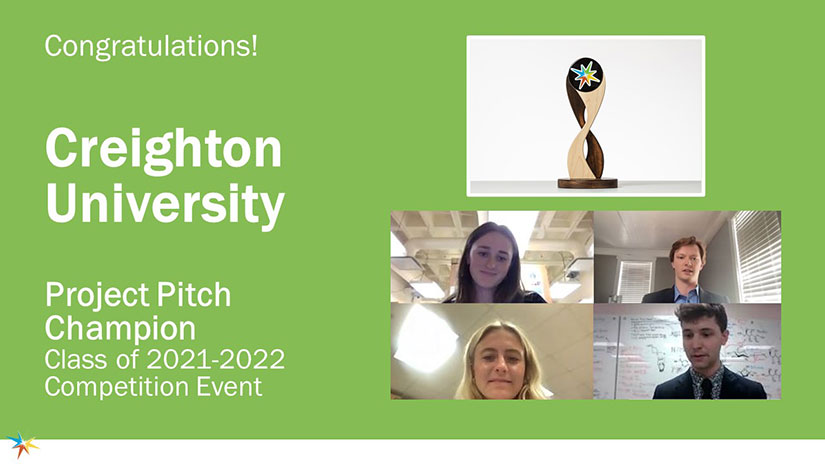Department of Energy Announces Solar District Cup Class of 2021–2022 Winners
Nine Student Teams Earn Division Winner Titles for Solar-Plus-Storage Designs
On Monday, April 25, the U.S. Department of Energy announced the top division winners and Project Pitch Champion in the Solar District Cup Collegiate Design Competition Class of 2021–2022. A total of nine student-led teams won first, second, or third place across the three divisions, plus four honorable mentions.
On Sunday, April 24, student teams presented their designs and models for distributed energy systems to a panel of industry judges and their division peers. On Monday, the top three teams in each division, plus honorable mentions, were announced, and the three first-place teams were invited to pitch their concepts to a public audience that afternoon. Following presentations, an audience of nearly 200 attendees voted on the most promising design to select the Project Pitch Champion.

The Solar District Cup, now in its third year, challenges multidisciplinary student teams to develop systems that integrate solar, storage, and other distributed energy capabilities across mixed-use districts, or groups of buildings served by a common electrical distribution feeder. The competition engages students across the engineering, urban planning, finance, and other disciplines to reimagine how energy is generated, managed, and used in a real-world district.
For the Class of 2021–2022 edition of the competition, the district use cases for which students designed solar-plus-storage solutions were Cheyney University of Pennsylvania, The Ohio State University, and Pacific Northwest National Laboratory.
The competition is designed to inspire students to consider new career opportunities, learn industry-relevant skills, engage with the professional marketplace, and prepare to lead the next generation of distributed solar energy.
“As renewable energy deployment grows, so does the demand for a skilled workforce that can implement and optimize new technologies,” said Alejandro Moreno, U.S. Department of Energy deputy assistant secretary for renewable power, who announced the division winners. “The Solar District Cup encourages engagement with and awareness of new clean energy technologies among college students—and hopefully inspires them to utilize their newfound skills in this rapidly changing industry.”
Throughout the competition, student teams were asked to design, model, and present the most cost-effective system possible with resilience services for one of three district use cases. At the April 24 competition event, 28 competing teams presented their concepts to a panel of industry judges. The projects were evaluated based on their potential to maximize the district’s energy offset and financial savings over the life of the system while integrating aesthetic, infrastructure, and community considerations.
The Solar District Cup Class of 2021–2022 division winners are as follows:
Cheyney University of Pennsylvania District Use Case Division

1st: Creighton University – This team was awarded for their excellent approach and explanation of key financial factors that were thoroughly evaluated and researched. The team’s PV system design, tracker angular rotation schedule, distribution analysis, and financial analyses demonstrated a strong grasp of renewable energy development. Their proposal made a compelling case as to why their solution was the best choice for the district.
2nd: Appalachian State University – This team had a unique approach to agrivoltaics and thoughtful considerations of operations and maintenance. The team's distribution analysis demonstrated a clear understanding of limiting factors and costs. Overall, the proposal struck a balance between financial return and customer impact, both in terms of design and savings.
3rd: Illinois State University – This team was selected for their excellent proposal with thoughtful details, including the battery energy storage system operation. Their distribution analysis made excellent use of the OpenDSS tool, demonstrating a multi-faceted analysis. The judges found the team’s solar paver concept to be an original and innovative twist.
Honorable Mention: Northeast Lakeview College and San Antonio College – This team was recognized for their strong design and in-depth research on campus monetization and overall objectives of the university.
Honorable Mention: Texas Southern University – This team was honored for demonstrating significant research about the legacy and current needs of historically black colleges and universities with a strong focus on community engagement.
The Ohio State University District Use Case Division
1st: Embry-Riddle Aeronautical University – This team was awarded for their display of advanced technical knowledge in solar installation, their robust analysis of the distribution system impacts and voltage implications, and the pop and pizzazz of their proposal document.
2nd: Southern Illinois University Carbondale, Case Western Reserve University, and The University of Texas at Dallas – This team had a comprehensive approach to balance-of-system accounting and a demonstrably firm grasp of the district’s goals and needs.
3rd: NC State University – This team demonstrated mastery of modeling best practices using detailed cost build-ups and had a creative approach to system design using bifacial modules and single-axis tracking.
Honorable Mention: Georgia Institute of Technology – This team was recognized for their solid financial analysis that demonstrated a thorough understanding of federal tax incentives and the cost bases to which they apply.
Pacific Northwest National Laboratory District Use Case Division
1st: Drexel University – This team was awarded for presenting a right-sized PV system, placing a focus on resiliency that was spot-on for the use case. The judging panel appreciated the detailed development plan, which incorporated considerations for zoning, aesthetics, airport glare, community impacts, and more. The judge panel enjoyed the frank discussion on economics and the focus on resiliency, as shared in their polished presentation.
2nd: Carnegie Mellon University – This team did awesome work presenting proposal information efficiently and professionally. The team had a great battery focus for critical loads and comprehensively considered numerous elements. The team had a very strong stakeholder plan that included electric vehicle charging and community engagement. It was also one of the only teams that considered jobs with their solar training concept.
3rd: University of Puerto Rico, Mayagüez Campus – This team was selected for their amazing work in considering zoning, aesthetics, master plan, flood risk simulation, and timeline related to permit, procurement, and testing. The judge panel appreciated the team discussion of risks, research opportunities, and community workshops. The judges also appreciated the techno-economic analysis of their energy storage technologies.
Honorable Mention: University of Colorado Boulder – This team was recognized for the consideration of solar carports and accountability for their own distribution line on campus.
After the announcement of top teams in each division, the three first-place teams moved on to the Project Pitch Championship on April 25, where they presented condensed pitches to a public audience. Ultimately, Creighton University was voted Project Pitch Champion for the Class of 2021–2022.
“The three teams that presented today demonstrated highly innovative solutions for integrating solar and storage, demonstrating huge potential for advances in contained energy systems,” said Garrett Nilsen, acting director of the U.S. Department of Energy Solar Energy Technologies Office. “It’s been exciting to see the progress made among the teams throughout the year, and the final project pitches make the future of solar and other renewables look bright.”
During the competition, students receive access to educational resources and tools provided by partnering organizations, including Aurora Solar Inc., Energy Toolbase, HeatSpring LLC, and RE+ Events, formerly known as Solar Power Events. These partners provide benefits including access to design and analysis software tools, online educational courses, and networking opportunities with industry professionals. The district use case partners of Cheyney University of Pennsylvania, The Ohio State University, and Pacific Northwest National Laboratory shared valuable district and campus data with students to enhance the depth of their projects. Their collective support is essential to student success in the competition and career development.
Congratulations to all of the competing teams in the Solar District Cup Class of 2021–2022!
Learn more about the Solar District Cup.
Last Updated May 28, 2025
